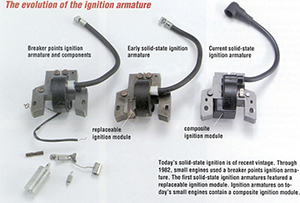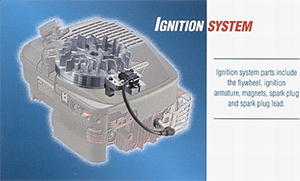Experiencing issues with your Briggs & Stratton magneto? You’re not alone.
Many small engine owners face similar problems. Understanding how to troubleshoot your Briggs & Stratton magneto can save you time and money. This guide provides easy steps to identify and fix common magneto issues. Whether your engine won’t start, runs poorly, or has no spark, this troubleshooting guide has you covered.
With clear, straightforward advice, you’ll learn how to diagnose and resolve magneto problems. Get ready to restore your engine’s performance and reliability. Dive in and discover the simple solutions to get your engine running smoothly again.
Introduction To Magneto Issues
Understanding magneto issues in Briggs & Stratton engines is crucial. A magneto generates the spark needed for combustion. Without it, the engine won’t start. Identifying and fixing magneto problems can save time and money.
Common Symptoms
Several symptoms indicate magneto issues. These signs include weak or no spark. The engine may also misfire or run poorly. If the engine won’t start, the magneto could be the culprit.
Importance Of Timely Fixes
Fixing magneto problems quickly is essential. Delayed repairs can lead to more damage. This can result in costly repairs or replacements. Addressing issues early can prevent further engine damage.
Tools Needed For Troubleshooting
Troubleshooting a Briggs & Stratton magneto can be a straightforward task. Having the right tools is essential. The correct tools can make the process easier and more efficient. This section will cover the tools you need for successful troubleshooting.
Essential Tools
To troubleshoot a Briggs & Stratton magneto, you will need basic tools. A spark tester is a must-have. This tool helps you check the spark plug’s function. Another key tool is a multimeter. It measures voltage, current, and resistance. You will also need a screwdriver set. Different sizes ensure you can handle various screws. Lastly, keep a wrench set handy. It helps you remove and tighten bolts easily.
Optional Tools
While not essential, some tools can make the job easier. A feeler gauge measures the gap between the magneto and flywheel. This tool ensures accurate measurements. A torque wrench is also useful. It helps you apply the correct amount of force when tightening bolts. Finally, an ignition coil tester can be beneficial. This tool checks the coil’s condition, saving time in diagnosing issues.
Safety Precautions
When troubleshooting the Briggs & Stratton magneto, safety should be your top priority. Following proper safety measures can prevent accidents and injuries. Below, we’ll cover essential personal and equipment safety tips.
Personal Safety Tips
- Always wear protective gear. Safety glasses, gloves, and closed-toe shoes are a must.
- Disconnect the spark plug. This prevents accidental engine start-up.
- Work in a well-ventilated area. Avoid inhaling fumes from the engine.
- Keep a first-aid kit handy. It’s better to be prepared for minor injuries.
Equipment Safety
- Ensure the engine is cool. Hot engines can cause burns.
- Use the right tools. Incorrect tools can damage the magneto or engine.
- Check for fuel leaks. Fuel leaks can be hazardous when working on the engine.
- Follow the manual. Always refer to the manufacturer’s instructions for troubleshooting steps.
Diagnosing Magneto Problems
Experiencing issues with your Briggs & Stratton magneto? Diagnosing these problems can be straightforward. By performing a few checks, you can identify the problem and find a solution. Follow these steps to troubleshoot your magneto effectively.
Visual Inspection
Start with a visual inspection of the magneto. Look for obvious signs of wear or damage. Check for loose connections, corroded terminals, and any visible cracks or breaks.
- Inspect the magneto’s housing for cracks.
- Check for any burnt or discolored areas.
- Examine the wiring for wear or fraying.
These visual clues can help you identify if the magneto needs repair or replacement.
Using A Multimeter
If the visual inspection reveals no issues, use a multimeter to test the magneto. This device measures electrical resistance and can tell if the magneto is functioning properly.
- Set the multimeter to the resistance (ohms) setting.
- Connect the multimeter’s probes to the magneto’s terminals.
- Read the resistance value on the multimeter’s display.
Compare the reading to the manufacturer’s specifications. If the value falls outside the recommended range, the magneto may be faulty.
A table can help you understand the multimeter readings:
| Resistance Reading (Ohms) | Status |
|---|---|
| 0 – 0.5 | Short circuit |
| 0.5 – 10 | Operational |
| 10 – Infinite | Open circuit |
Testing with a multimeter ensures that you accurately diagnose the magneto’s condition. By following these steps, you can determine if the magneto needs repair or replacement.
Fixing Common Magneto Issues
Briggs & Stratton magneto problems can cause your engine to misfire. Understanding and fixing common issues can save you time and money. Here, we will discuss two primary fixes: replacing the spark plug and cleaning the ignition coil.
Replacing Spark Plug
A faulty spark plug often causes engine problems. Start by locating the spark plug on your engine. Remove the spark plug wire carefully. Use a spark plug wrench to unscrew the old spark plug. Check for signs of wear or damage. If the spark plug is dirty or cracked, replace it with a new one. Ensure the new spark plug matches your engine specifications. Screw in the new spark plug by hand, then tighten with the wrench. Reconnect the spark plug wire securely. This simple replacement can solve many magneto issues.
Cleaning Ignition Coil
A dirty ignition coil can prevent proper engine function. First, locate the ignition coil on your engine. Disconnect the wires attached to the coil. Remove the ignition coil using a screwdriver. Clean the coil with a soft brush or cloth. Remove any dirt or debris. Inspect the coil for cracks or damage. If the coil is damaged, replace it. Reinstall the cleaned coil and reconnect the wires. Cleaning the ignition coil can restore proper engine performance.

Credit: www.youtube.com
Advanced Troubleshooting Techniques
Advanced troubleshooting techniques can help you diagnose and fix complex issues with your Briggs & Stratton magneto. Sometimes, basic troubleshooting steps are not enough. This is where advanced techniques come in handy. These methods require a bit more technical know-how, but they can save you time and effort.
Testing Flywheel Magnet
The flywheel magnet plays a crucial role in generating the necessary spark. To test the flywheel magnet, follow these steps:
- Remove the flywheel cover carefully.
- Locate the magnet on the flywheel.
- Use a screwdriver to check the magnet’s strength. The screwdriver should be attracted firmly.
- If the magnet is weak, it needs replacement.
Checking Wiring Connections
Wiring connections are vital for the magneto’s proper operation. Loose or damaged wires can lead to failure. Here’s how to check the wiring connections:
- Inspect all wires connected to the magneto.
- Look for signs of wear or damage.
- Ensure all connections are tight and secure.
- Use a multimeter to test continuity in the wires. If a wire fails the test, replace it.
Proper maintenance and advanced troubleshooting techniques ensure your Briggs & Stratton magneto works efficiently. Regular checks can prevent major issues and prolong the life of your equipment.
Preventive Maintenance Tips
Preventive maintenance is key to keeping your Briggs & Stratton engine running smoothly. Taking care of your magneto is crucial. Here are some simple tips to help you maintain it effectively.
Regular Inspections
Performing regular inspections is essential. Check for any visible damage or wear on the magneto. Look for cracks, rust, or other signs of deterioration.
Use a clean cloth to wipe off any dirt or debris. This helps prevent buildup that can affect performance.
| Inspection Task | Frequency |
|---|---|
| Check for damage | Monthly |
| Clean the magneto | Every 3 months |
Use a flashlight to inspect hidden areas. Ensure all connections are tight and secure.
Proper Storage
Storing your engine properly can extend the life of the magneto. Keep it in a dry, cool place. Avoid damp or humid environments.
Cover your engine with a protective sheet. This prevents dust and moisture from accumulating.
- Store in a dry, cool place
- Use a protective cover
- Keep away from direct sunlight
Remove the spark plug if storing for a long time. This prevents rust and corrosion.
Follow these preventive maintenance tips to ensure your Briggs & Stratton magneto stays in top shape. Regular care can save you from costly repairs in the future.

Credit: www.briggsandstratton.com
When To Seek Professional Help
Troubleshooting a Briggs & Stratton magneto can be tricky. While some issues can be fixed at home, others might need professional help. Knowing when to seek professional assistance can save you time and ensure the job is done right.
Identifying Complex Issues
Some magneto problems are easy to spot. Others are not. Complex issues may involve the internal components of the magneto. These parts need special tools and knowledge to repair. Here are some signs that you might need a professional:
- Engine won’t start after multiple attempts
- Frequent misfires or poor engine performance
- Visible damage to the magneto or its components
- Strange noises coming from the engine area
If you notice any of these signs, it’s best to consult a professional.
Choosing A Repair Service
Finding the right repair service is crucial. Not all services are created equal. Here are some tips to help you choose:
- Check reviews online for the service provider.
- Ask for certifications. Certified technicians often provide better service.
- Compare prices. Get quotes from multiple services.
- Look for warranties. A good service will offer a warranty on their work.
By following these steps, you can find a reliable repair service. This ensures your Briggs & Stratton magneto is in good hands.

Credit: www.briggsandstratton.com
Frequently Asked Questions
How Do I Know If My Magneto Is Bad?
A bad magneto may cause weak or no spark, engine misfires, or difficulty starting. Test with a multimeter for confirmation.
Why Are My Briggs And Stratton Not Sparking?
Your Briggs and Stratton engine may not be sparking due to a faulty spark plug, ignition coil, or damaged wiring. Check these components for issues.
What Is The Gap Between The Ignition Coil And Flywheel On A Briggs And Stratton Engine?
The gap between the ignition coil and flywheel on a Briggs and Stratton engine should be 0. 010 to 0. 014 inches. Use a feeler gauge to set the correct gap for optimal performance.
How Do I Know If My Briggs And Stratton Coils Are Bad?
Test Briggs and Stratton coils with a multimeter. Check for continuity and proper resistance. Inspect for visible damage.
How Do You Test A Briggs & Stratton Magneto?
Test with a spark tester. Connect it between the spark plug and the wire. Pull the starter rope. Check for spark.
Conclusion
Troubleshooting a Briggs & Stratton magneto can seem tough at first. With the right steps, it becomes easier. Identify the problem, check connections, and replace faulty parts. Regular maintenance prevents future issues. Always follow safety measures during repairs. Understanding your engine will save you time and money.
Now, you can tackle magneto issues with confidence. Happy troubleshooting!
